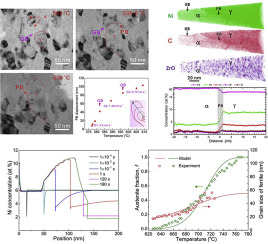当前位置:
X-MOL 学术
›
Acta Mater.
›
论文详情
Our official English website, www.x-mol.net, welcomes your
feedback! (Note: you will need to create a separate account there.)
Grain boundary-constrained reverse austenite transformation in nanostructured Fe alloy: model and application
Acta Materialia ( IF 8.3 ) Pub Date : 2018-08-01 , DOI: 10.1016/j.actamat.2018.05.021 Linke Huang , Weitong Lin , Kang Wang , Shaojie Song , Can Guo , Yuzeng Chen , Yujiao Li , Feng Liu
Acta Materialia ( IF 8.3 ) Pub Date : 2018-08-01 , DOI: 10.1016/j.actamat.2018.05.021 Linke Huang , Weitong Lin , Kang Wang , Shaojie Song , Can Guo , Yuzeng Chen , Yujiao Li , Feng Liu

|
Abstract Reverse austenite transformation (RAT) is critical for designing advanced high-strength steels (AHSS), which, however, has not been sufficiently studied in nanostructured (NS) steels or Fe alloys, and hence not fully understood yet. Herein, the RAT (e.g. ferrite to austenite) kinetics in the NS Fe alloy upon continuous heating was experimentally and theoretically investigated, where, the ultrafine austenite characterized by a sluggish growth velocity and a high thermal stability, and additionally, an appreciable solute partitioning detected using atom probe microscopy, indicate the diffusion-controlled mechanism of RAT. The double-edged role of grain boundaries (GBs) in the NS alloy is elucidated, i.e. enhancing the diffusivity due to the type-A kinetics, and simultaneously, facilitating the formation of constrained diffusion field mainly due to the segmented effect of GB nucleation. On this basis, a modified diffusion model incorporating the effect of GBs is implemented to understand the GB-constrained austenite growth and the associated partitioning behavior, and further complemented with Cahn model, an austenite growth model is applied to predict the overall kinetics of RAT in the NS Fe alloy. It then follows that a strategy by combination of diffusion-controlled growth model and microstructure model could serve as a framework to predict the kinetics of RAT in the NS alloys. Regarding the RAT kinetics in the NS alloys, the present work uncovers the ‘GB-constrained’ mechanism, which is expected to offer the potential application for nanostructure manipulation in the development of AHSS.
中文翻译:

纳米结构铁合金中晶界约束的逆奥氏体转变:模型与应用
摘要 逆奥氏体转变 (RAT) 对于设计先进的高强度钢 (AHSS) 至关重要,然而,在纳米结构 (NS) 钢或 Fe 合金中尚未对其进行充分研究,因此尚未完全了解。在此,通过实验和理论研究了 NS Fe 合金在连续加热时的 RAT(例如铁素体到奥氏体)动力学,其中,超细奥氏体具有缓慢的生长速度和高热稳定性,此外,检测到可观的溶质分配使用原子探针显微镜,表明 RAT 的扩散控制机制。阐明了 NS 合金中晶界 (GB) 的双刃作用,即由于 A 型动力学而增强扩散性,同时,促进约束扩散场的形成主要是由于GB成核的分段效应。在此基础上,实施了包含 GB 效应的修正扩散模型以了解 GB 约束的奥氏体生长和相关的分配行为,并进一步辅以 Cahn 模型,应用奥氏体生长模型来预测 RAT 的整体动力学NS铁合金。然后,通过结合扩散控制生长模型和微观结构模型的策略可以作为预测 NS 合金中 RAT 动力学的框架。关于 NS 合金中的 RAT 动力学,目前的工作揭示了“GB 约束”机制,有望为纳米结构操纵在 AHSS 的发展中提供潜在的应用。
更新日期:2018-08-01
中文翻译:

纳米结构铁合金中晶界约束的逆奥氏体转变:模型与应用
摘要 逆奥氏体转变 (RAT) 对于设计先进的高强度钢 (AHSS) 至关重要,然而,在纳米结构 (NS) 钢或 Fe 合金中尚未对其进行充分研究,因此尚未完全了解。在此,通过实验和理论研究了 NS Fe 合金在连续加热时的 RAT(例如铁素体到奥氏体)动力学,其中,超细奥氏体具有缓慢的生长速度和高热稳定性,此外,检测到可观的溶质分配使用原子探针显微镜,表明 RAT 的扩散控制机制。阐明了 NS 合金中晶界 (GB) 的双刃作用,即由于 A 型动力学而增强扩散性,同时,促进约束扩散场的形成主要是由于GB成核的分段效应。在此基础上,实施了包含 GB 效应的修正扩散模型以了解 GB 约束的奥氏体生长和相关的分配行为,并进一步辅以 Cahn 模型,应用奥氏体生长模型来预测 RAT 的整体动力学NS铁合金。然后,通过结合扩散控制生长模型和微观结构模型的策略可以作为预测 NS 合金中 RAT 动力学的框架。关于 NS 合金中的 RAT 动力学,目前的工作揭示了“GB 约束”机制,有望为纳米结构操纵在 AHSS 的发展中提供潜在的应用。











































 京公网安备 11010802027423号
京公网安备 11010802027423号